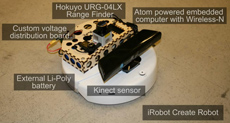Kinect and iRobot: A Love Story
-
-
slice.mit.edu
- 1
Filed Under
Recommended

Since Microsoft released the Kinect gaming system last month, science geeks of all stripes have been hacking it to use the cameras, sensors, and software that detects movement, depth, and body shape and position for other than Microsoft's intended purpose—which is to control the action of an Xbox video game through gestures. Read the Wired article about how Kinect's motion detection works.
Limor Fried '03, MNG '05, engineer and founder of Adafruit Industries, which sells original DIY electronics kits, and Phillip Torrone, Adafruit designer and senior editor at Make magazine, offered $3K to the first person to create and distribute free software allowing the Kinect to be used with a computer instead of an Xbox. Originally the prize was $1K, but they doubled then tripled it after hearing Microsoft's reaction to the contest: "Microsoft does not condone the modification of its products," a company spokesperson told CNET. "With Kinect, Microsoft built in numerous hardware and software safeguards designed to reduce the chances of product tampering. Microsoft will continue to make advances in these types of safeguards and work closely with law enforcement and product safety groups to keep Kinect tamper-resistant." Microsoft has since reversed its stance and embraced the hackers.
One hack was created by Philipp Robbel SM '07, a PhD student with the MIT Media Lab's Personal Robots Group. He married an iRobot Create device with the Kinect to form what he calls the KinectBot. It reconstructs a 3-D representation of the environment and can be directed using natural gestures. He told the New York Times that one potential use for KinectBot could be to search for survivors after natural disasters.








Comments
Josh
Sun, 12/05/2010 3:08pm
This is some really cool stuff that they are doing with the technology I hope some really good things come out of it.